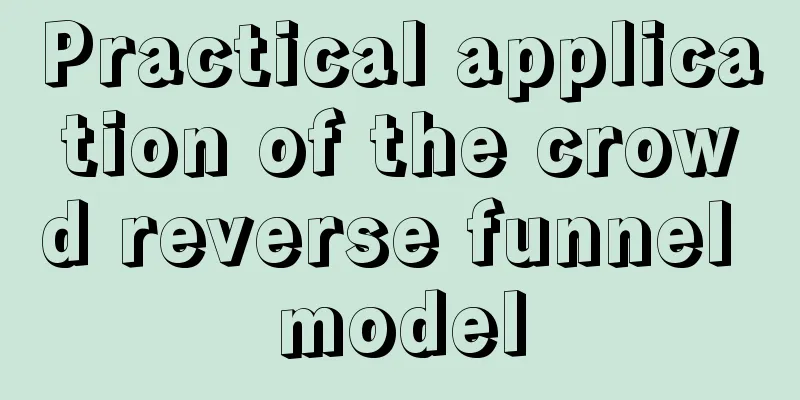When everyone understands that "free is the most expensive", operations go crazy

Sometimes you will meet some people outside who say they will give you small gifts such as small fans and headphones for free. The next second after you take it, they will take out their mobile phone from their pocket and ask you to add them on WeChat, so as to turn you into private traffic. When dining, some restaurants will have activities where you can get free dishes by posting on WeChat Moments; sometimes you will receive sales calls saying that you can get free gifts if you come to the event, but these calls are usually treated as scams and the call is hung up on. Those who give you things for free are not necessarily all scammers; they may also be poor operators who are trying to meet their KPIs. Nowadays, the idea that "free is the most expensive" is deeply rooted in people's minds, so that no matter what is given as a gift, few users are willing to participate, even the number of grandpas and aunts collecting eggs on the street has decreased. Why can’t even “free gifts” attract users now? As operators, what should we do? We started a discussion on Tiantianwen. Let’s see what our friends have to say~ 1. Do users really dislike “free stuff”?The answer is no. Who wouldn't like a good thing that falls from the sky? However, for various reasons, people no longer believe in it. 1. LazinessDon't disbelieve it, there really are people who are too lazy to take free gifts even when they are placed in front of them. However, this laziness is also reflected in the way of obtaining gifts. If you simply add WeChat or public accounts, maybe 50% of users will participate; if you post on Moments, maybe only 30% of users will participate; if you not only post on Moments, but also get multiple likes, maybe less than 10% of people will participate. Everyone's time and energy are limited. In the fast-paced urban life, people will not waste any energy on things that have nothing to do with them. The more complicated the way to receive gifts is, the less willing users are to participate. 2. The value of the gift is less than personal privacyWhat are the free gifts? Generally speaking, the gifts are of low value. For users, if they think the value of the labor they put in is greater than the goods they get, or that the application scenarios of the goods they get are not sufficient, they are unwilling to participate. This also causes some people to not be attracted - it's not worth it. It is well known to many people that free things are only free of cost, not "free of cost". Scanning a QR code to add a friend, following a public account, or posting to a Moments, registering an account, these are all intrusions into the user's privacy circle. When they think they are being invaded, they will refuse to participate. Faced with the choice of free gifts and privacy, most people will choose the latter. 3. This is a good thing, but users don’t know itThere are indeed good things in free gifts, such as knowledge, provided that the user already knows the value of what you give away. For example, if your company spends a lot of money to invite an industry expert to give a lecture, as an operator, you try your best to use various publicity methods to promote the strengths of this guest, and give away exquisite gifts to attend the lecture. As a result, your users only pay attention to the gifts they don't like, and don't pay attention to the real value of this lecture at all. If you want users to understand the value, it will take some time. This in turn causes some people to not be attracted - they don't know what value this thing has. 4. It’s not that you can’t attract users, it’s that you don’t choose the right usersThe same activity, with the same budget, has completely different effects when held on the streets of first-tier cities and at the fairs in fourth-tier towns. The former is deserted, while the latter is packed with people. Just like why most of the participants in the free egg event are elderly people and there are very few young people. Because young people’s time is too precious. They work on weekdays and rest at home or go out to socialize on weekends. They have very few opportunities to stop for an “egg delivery event”. And they have too many ways to get eggs. They can place an order through grocery shopping apps and the eggs can be delivered in half an hour. Why go out? Only the elderly have plenty of time and the concept of thrift is "ingrained in their bones". They are willing to argue for a long time over every penny in the vegetable market. Naturally, they are unwilling to miss the opportunity to get free eggs, not to mention that the price they pay is just downloading an APP that they will never use. 2. “Free gift” is no longer valid, how to operate the activity?The psychological process of many operators when they first start doing "free giveaway" activities is: I have done a free activity and given away gifts, and then there will be large numbers of users paying attention, large numbers of users converting, and then I will be praised, promoted, and get a raise. Are all free activities going to be very effective and have high customer satisfaction rates? The answer is no. Why? Because your free service is not maximizing its effect. What is the maximum effect? To achieve the maximum effect, two conditions must be met:
Therefore, as long as you can find something that seems to be of high value, low cost, and something that others really need and give it to users as a "free gift", such "free gifting" is still feasible. In this article, let’s go a little deeper, not just looking at the “free giveaway” activity, but also talking about what kind of vision the current operations should have? Taking a diaper brand as an example, how does it carry out its marketing activities? In the past, the tactics commonly used to sell diapers were: increasing the quantity without increasing the price; buy one get one free; buy a diaper and get a free baby wipe. Simple and direct, it uses the user's "greed" mentality to do marketing, hoping to retain users by giving away gifts. However, as marketing is abused and the amount of advertising information users receive increases, the value of this ordinary discount model in the minds of users decreases. So we will start to consider positioning, scenarios, and population segmentation so that marketing can continue to attract users. Do a good job of brand positioning and population segmentation, and research various scenarios for the use of diapers. An ordinary diaper can be transformed into a super absorbent diaper, a side leakage-proof diaper, a pants-type diaper, an elastic waistband diaper... Diaper sales continue to rise in response to different scenarios encountered by users. With sales volume, diaper manufacturers will continue to think about how to make more money. The “80/20 rule” is well known. Manufacturers can only make more profits if they can continue to allow 20% of their core users to output value. But this is all that diapers can do. Do they have to have gold edges? "Consumer psychology", "brand" and "pricing strategy" emerged. So, you will see such advertisements on TV: What we buy is not diapers, but a bright future for our children. Taking advantage of parents' excessive concern about the healthy growth of the next generation, we increase the brand added value of diapers and create a diaper brand with a better future image. For example, children's sleep is related to brain development. Poor rest will hinder children's development. Diapers that are not dry will prevent children from getting a good rest. Therefore, using XXX diapers can bring a dry experience to children, allowing babies to sleep peacefully, mothers to rest assured, and the future will be comfortable. Then, the price of this diaper was tripled. So, what are we discussing when we discuss that “free gifts” cannot attract users? Free gifts, discount promotions, and discounts on purchases over a certain amount are all promotional activities. When the discounts fail to attract users, we need to consider whether there is something wrong with the strategy. For undeveloped markets, products are initially driven mainly by demand to meet users’ core needs, and discounts should be tied to core functions. For a market that is close to maturity, products need to satisfy the needs of a certain group of people in the mid-term, and discounts should be based on differentiation, that is, how to reflect product differences. It’s not that you can’t do free giveaways, but you can’t do them at the beginning. If the purpose of the activity is to attract new users, then nine out of ten such activities will fail—even if they don’t fail, the users attracted may not be the target users. But if it is used for activation or retention, it is more effective. For fully mature markets, the product stability period needs to focus on enhancing brand value, pricing and profitability, and discounts are naturally centered on the brand. Different products and different growth cycles require corresponding operating strategies. It is impossible to rely on the trick of "giving away for free" to be successful everywhere. 3. ConclusionThanks to our country's long-term anti-fraud propaganda, people have become more vigilant about the word "free". But for operators, it is becoming increasingly difficult to attract new customers and retain customers by giving away free gifts. The era of wanting to gain a large number of users through small favors is over. The long-term solution is to make products with care, carefully study user psychology, and expand product usage scenarios. Part of the content of the article comes from the wonderful answers of @大鱼汤海棠@木頭||杨智茗@Jack. This question is edited and published by @Darcy. Reprinting is prohibited without permission. The title image is from Unsplash, based on the CC0 agreement |
<<: HEYTEA: A look at its powerful digital operations capabilities
>>: How can something so ugly that it hurts the eyes become a trend?
Recommend
New business derived from short dramas: editing videos, posting links, earning commissions...
In addition to short video platforms, the short dr...
How much does it cost to open a store on eBay? What are the tips?
There are many cross-border e-commerce platforms. ...
The 146th day of Hema’s “turning over the table”
Hema has been plagued by negative news recently. F...
What is the Amazon Account Health Rating feature? Detailed introduction
Currently, there are nearly 2 million sellers on A...
Thinking training in life: Use cases around you to develop analytical skills!
Analytical ability is one of the important abiliti...
Offline explosion: Invest 200 yuan and earn 400,000 yuan
Why are online brands moving offline? The author a...
Vipshop’s “Special Sale Arena”
Vipshop has gained wide recognition and praise fro...
E-commerce giants suffer from "traffic anxiety"
Why do e-commerce giants suffer from "traffic...
Breaking out of the Red Ocean | Good content drives new brand growth
This article uses ten sentences and ten case studi...
Before joining Haidilao, did you know that it does not make money from products and services?
Haidilao has always been famous for its service at...
How long can Wahaha continue to reap the benefits of traffic?
Wahaha, which became popular in March, has reaped ...
How long does it take for Amazon video ads to be reviewed? What are the requirements for uploading video ads?
Many of you are now doing cross-border e-commerce,...
I use AI to help 1,000 expectant mothers predict their babies' appearance, selling each order for 9.9 yuan
While large companies are exploring the commercial...
Say goodbye to your “low-energy” self and transform from a “startup dog” to a “startup mad dog”!
Starting a business is a life-or-death game. Many ...
The number of followers increased by tens of millions in two weeks, and the daily income was one million, but "Guo Youcai" began to suffer from the backlash of traffic?
Recently, Guo Youcai has become extremely popular,...









